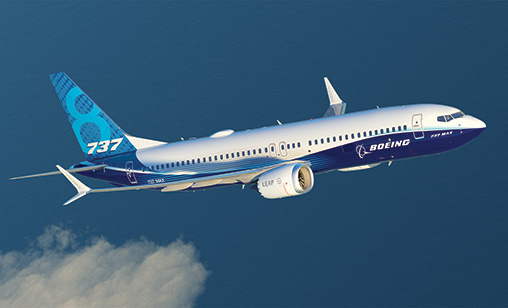News Backgrounder
Boeing’s battle to restore reputation
The timing of the return to service of Boeing’s 737 MAX remains in doubt as regulators from around the world closely study the fix Boeing has developed for the jet’s anti-stall system. However long it takes, the impact of the type grounding is hitting Boeing hard, reports associate editor, Tom Ballantyne.
May 1st 2019
When Boeing disclosed last month that its first quarter financial results had slumped 13%, the news was the first indication of the impact on the company’s bottom line of the global grounding of its B737 MAX jet: an estimated US$1 billion since the fleet was taken out of operations on March 13. Read More »
That, however, is the tip of the iceberg. The sum only pertains to an increase in production costs for the aircraft. It does not include the predicted compensation Boeing is expected to pay to the families of the 346 victims of the Lion Air and Ethiopian Airlines fatal crashes and to the airlines with grounded jets. To be added to the bill will be the indefinable damage done to the Boeing brand and a potential loss of orders to Airbus by airline customers. The final cost will be billions more.
 |
On May 1, Boeing announced it had appointed its general counsel, J. Michael Luttig, to “manage all legal matters associated with the Lion Air flight 610 and Ethiopian Airlines Flight 302 accidents”. The Chicago-headquartered company said Luttig will advise its chairman, president and CEO, Dennis Muilenburg, and the Boeing board of directors.
In Australia, the new CEO of Virgin Australia, Paul Scurrah, last month deferred delivery of the first of its 737 MAX order, an -10. The first MAX 8 aircraft will arrive at VA in 2025. In late March, Garuda Indonesia announced it had asked Boeing for cancellation of its order for 49 737 MAXs. Garuda Indonesia was the first airline in the region to defer 737 MAX planes, a fleet revision it had been considering for several months.
In the meantime, it has become clear Boeing has adopted a slow and extremely cautious approach to convincing authorities the 737 Max is safe to fly. It did not, as expected at the first quarter results announcement, provide a date for its submission of the type’s update to the Joint Authorities Technical Review (JATR), the committee of nine aviation regulators that will review the changes to the aircraft’s automated flight control system. When Boeing does submit the documentation it will take at least three months to complete the review, likely grounding the MAX until August or September, at the earliest.
“Across the company, we are focused on safety, returning the 737 MAX to service and earning and re-earning the trust and confidence of customers, regulators and the flying public,” said Boeing chairman, president, and CEO, Dennis Muilenburg.
After the production of the MAX was reduced from 52 to 42 a month deliveries of all civil aircraft during the quarter fell to 149 units, a 19% decrease compared with the same quarter last year.
While Boeing profits remain healthy, at $2.1 billion compared with the same three months last year, revenues of $22.9 billion were down 1.98%. The planemaker said its backlog remains substantial at over 5,600 airplanes valued at $399 billion.
Meanwhile, the JATR, made up of the FAA, the European Aviation Safety Agency (EASA) and regulators from China, Australia, Brazil, Canada, Japan, Singapore and the United Arab Emirates (UAE) commenced their joint examination of the MAX update on April 29. The review is being chaired by former U.S. National Transportation Safety Board (NTSB) chairman. Chris Hart. “The team will evaluate aspects of the 737 MAX automated flight control system, including its design and pilots’ interaction with the system, to determine its compliance with all applicable regulations and to identify future enhancements that might be needed,” the FAA said.
 |
| 'In December 2018, Boeing convened a Safety Review Board (SRB) to consider again whether the absence of the AoA (Angle of Attack) Disagree alert from certain 737 MAX flight displays presented a safety issue. The SRB confirmed Boeing’s prior conclusion that it did not. Boeing shared this conclusion and the supporting SRB analysis with the FAA (Federal Aviation Administration) ' |
The review began after Boeing completed an engineering test flight on April 16 with the updated maneuvering characteristics augmentation system (MCAS). The software has been implicated in the two fatal accidents. Boeing test pilots completed 120 flights of 203 hours of airtime with the software solution. The manufacturer said more than 85% of the 50-plus MAX operators around the globe also had the opportunity to see the update in action during simulator sessions.
During the final test, flight control of a MAX was handed to FAA pilots to test the design enhancements. Boeing said the system will never again overwhelm flight crews, as it did in the two crashes.
Facing criticism it is too close to Boeing, the FAA has invited global regulators to a meeting in Washington DC on May 23 about the MAX as it works to restore public confidence in its oversight. At the forum the agency will outline its process for returning the MAX to service, an FAA official said.
On May 15, the U.S. house Transportation and Infrastructure Committee will hold a hearing on “the status of the Boeing 737 MAX”, Reuters reported, and the FAA’s aircraft certification program. U.S.Senate commerce committee chairman, Roger Wicker, told the news agency he plans to call Muilenburg to testify at a future date. “I think he will want to,” Wicker told Reuters.
Muilenburg , speaking at Boeing Field, south of Seattle last month, with MAX aircraft as a backdrop, said he had been a passenger on a demonstration flight and watched the final update to the MCAS software “operating as designed across a range of flight conditions”.
The upgrade is designed to make the anti-stall system less aggressive and prevent the repeated nose-down commands that overwhelmed flight crews flying the Lion Air and Ethiopian Airlines MAXs.
In addition, the MCAS will no longer be triggered by a single erroneous sensor reading as has been indicated in the two accidents. Muilenburg said Boeing’s ultimate goal is “to make the 737 Max one of the safest airplanes to ever fly”.